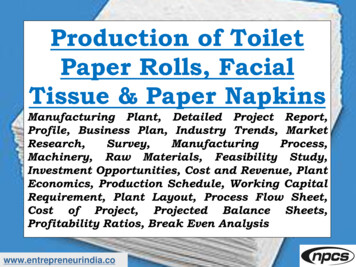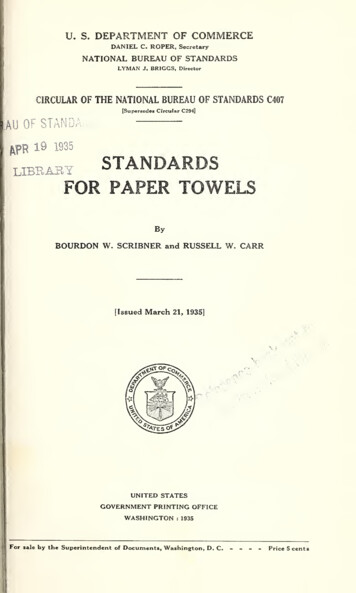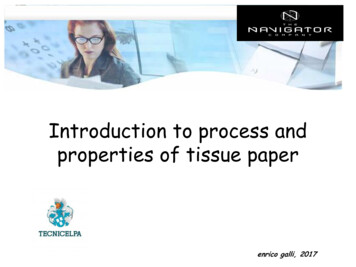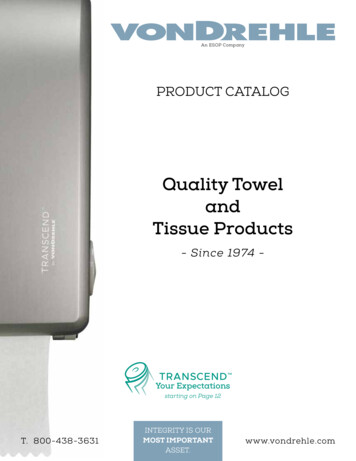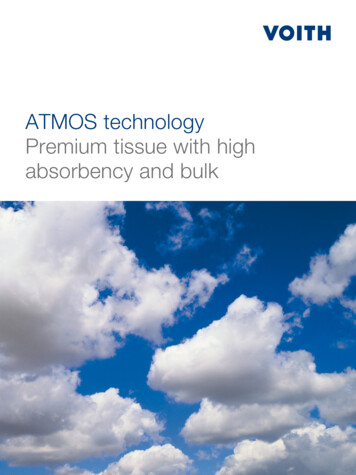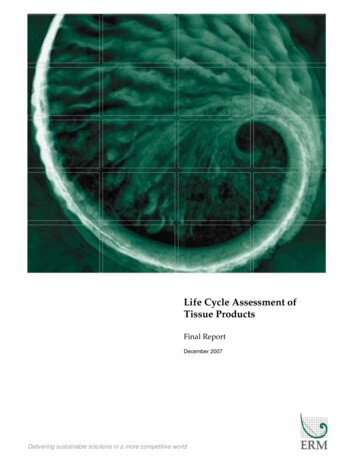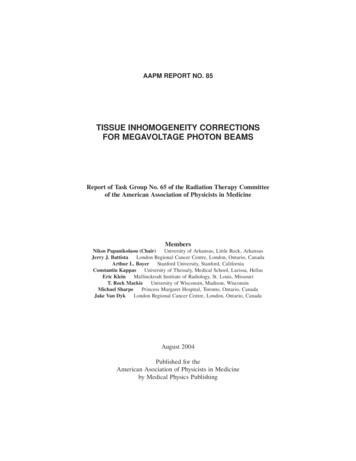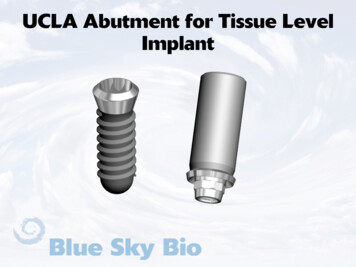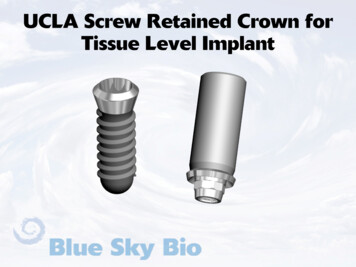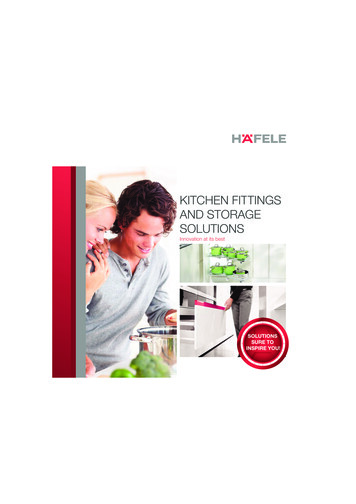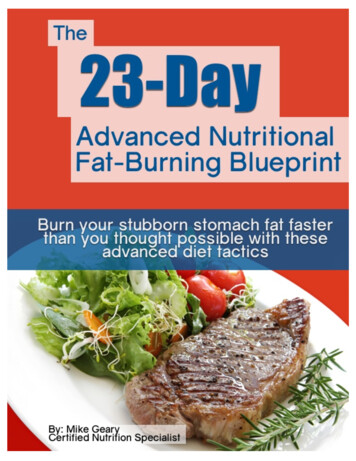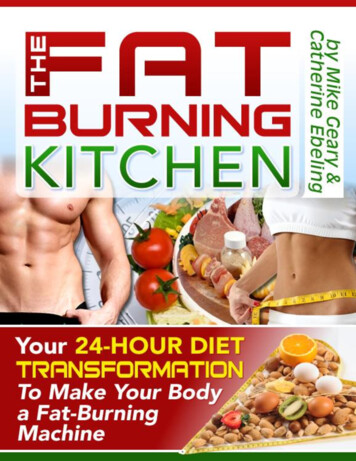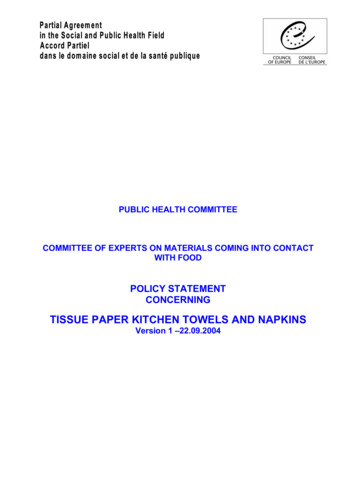
Transcription
PUBLIC HEALTH COMMITTEECOMMITTEE OF EXPERTS ON MATERIALS COMING INTO CONTACTWITH FOODPOLICY STATEMENTCONCERNINGTISSUE PAPER KITCHEN TOWELS AND NAPKINSVersion 1 –22.09.2004
NOTE TO THE READERThe Guidelines for tissue paper kitchen towels and napkins are part of the Council ofEurope’s Policy statements on food contact materials.Guidelines are technical documents and have no legal binding character.They have to be considered as requirements to be taken into account as models for theimplementation of national policies.They lay down technical and scientific specifications for the manufacture of food contactmaterials and articles.If necessary they are amended in the light of technical or scientific developments ofmanufacturing processes and techniques of food contact materials and articles.The Guidelines were elaborated by a Group of national experts after consultation with theEuropean Tissue Symposium (ETS) and adopted by the Committee of experts on materialscoming into contact with food.The document may be consulted on the Internet website of the Partial AgreementDepartment in the Social and Public Health Field:www.coe.int/soc-sp2
TABLE OF CONTENTSPage1.1.1.1.2.EXPLANATORY NOTEIntroductionGeneral principles5562.FIELD OF APPLICATION83.DEFINITION OF TISSUE PAPER KITCHEN TOWELS AND NAPKINS94.SPECIFICATIONS95.5.1.5.2.5.3.RAW MATERIALSFibrous ingredientsNon-fibrous ingredientsPrinting inks101010106.6.1.6.2.6.3.6.4.6.5.6.6.TEST CONDITIONS AND METHODS OF ANALYSISIntroductionTesting for purity restrictionsMigration test for tissue paperAntimicrobial effect test for tissue paperTests on PCP, heavy metals, and formaldehydeTests on colourants and fluorescent whitening agents111111111111127.7.1.7.2.7.3.7.4.7.5.RECYCLED FIBRESIntroductionClassification of recovered paperRecycling treatmentsEnd product testingConsolidated matrix1212121415168.8.1.8.2.8.3.8.4.GOOD MANUFACTURING PRACTICESIntroductionGeneral aspects and principlesAspects in particularInventory of hazards and suggested means of prevention1717181821APPENDIX 1Non-fibrous constituents for use in the manufacture of kitchen towels and napkinsIntroduction1.Functional additives2.Processing aids3.Exclusion list2727273135APPENDIX 2Description of substances typically used in printing inks for kitchen towels and s not to be used for kitchen towels and napkins3636363738APPENDIX 3Specific migration testing method for tissue 3939393
5.6.Migration testsCalculation of results3940APPENDIX 4Method to determine 1,3-dichloro-2-propanol and 3-chloro-1,2- propanediol inan aqueous extract of paper1.Principle2.Chemicals3.Apparatus4.Preparing samples5.Carrying out the experiment6.Calibration curves7.Gas chromatographic conditions8.Evaluation9.Detection limit of the procedure441414142424242434343
1.EXPLANATORY NOTE1.1.IntroductionThere is a wide range of products that are made from tissue paper, including toilet paper,wipes, kitchen towels, handkerchiefs, facial tissues, household towels, napkins, products forindustrial use, etc. Some tissue paper products, in particular kitchen towels and napkins, aresometimes put in contact with food by end users. These products exhibit the typicalcharacteristics of tissue paper, such as softness, high absorption capacity and limitedstructural strength.Tissue paper kitchen towels and napkins (hereafter, kitchen towels and napkins) aremultifunctional products. Their main use is for hygiene and cleaning purposes, and they arenot specifically intended for contact with foodstuffs. Food contact use remains limited andoccasional.The function of kitchen towels and napkins is primarily to clean and to absorb. Their use incontact with food is typically for a short period of time. In addition, it has been demonstratedthat there is no significant migration from kitchen towels and napkins into food1, andconsumer exposure is very low.In light of the products’ multi-purpose use, the fact that they are not specifically intended forcontact with foodstuffs, the absence of significant migration, and the low exposure of theconsumers, they are excluded from the field of application of the Council of EuropeResolution AP (2002) 1 on paper and board materials and articles intended to come intocontact with foodstuffs, and they are covered by these specific Guidelines. Consequently theTechnical documents implementing Resolution AP (2002) 1 do not apply either.The Guidelines for tissue paper kitchen towels and napkins (hereafter called ‘the Guidelines’)recommend specifications that tissue paper kitchen towels and napkins should comply within order to achieve safety of use for the consumer, in light of the general principles of theGeneral Product Safety Directive 2001/95/EC. Kitchen towels and napkins covered by theGuidelines should be manufactured in compliance with good manufacturing practice so that,under normal or foreseeable conditions of use, they do not endanger human health, or bringabout a deterioration of the organoleptic characteristics, or an unacceptable change in thecomposition of the food they may come into contact with.In order to ensure the safety of tissue paper kitchen towels and napkins, the followingaspects should be considered: Raw materials;Processing technologies;Intended use of the end product; andLevel of exposure.These aspects are basic elements of product safety, and appropriate tests should be carriedout to verify the safety of kitchen towels and napkins.The Guidelines do not contain an inventory list of chemicals used in paper manufacturingand converting of kitchen towels and napkins. They list instead chemical substances whichare typically used, as well as substances not to be used. The specific characteristics oftissue paper and, in particular, the low migration profile and the low consumer exposure1“Migration studies on tissues in contact with food”, Committee of experts on materials coming intocontact with food, RD 6.3D/1-39#1; and “Test report on presence of fluorescent whitening agents intwo samples”, Committee of experts on materials coming into contact with food, RD 6.3D/2-39#1.5
which have been demonstrated, warrant that the proposed control of chemicals, incombination with the other recommendations contained in the Guidelines, are appropriate toprotect consumers’ health.1.2.General principles1.2.1. IntroductionThe Guidelines are based on the specifications of Resolution AP (2002) 1 on paper andboard materials and articles intended to come into contact with foodstuffs. They have beenadapted in light of the specific characteristics and usage of tissue paper kitchen towels andnapkins.1.2.2. Raw materialsManufacturers of kitchen towels and napkins should use raw materials in accordance withthe principles contained in the Guidelines. Restrictions on the use of printing inks are alsocovered by the Guidelines.In restricting the materials that may be used to manufacture kitchen towels and napkins,account has been taken of the very low amounts of chemicals used in the manufacturingprocess. The Guidelines do not contain an inventory list of chemicals. Instead, they listchemical substances that are typically used, as well as substances that may not be used inthe manufacturing of kitchen towels and napkins. In addition, specific tests are required forthe chemicals that could potentially constitute a risk for consumers.The specific restrictions for the main chemical families used in tissue paper manufacturingcontained in the Guidelines are based on the solubility, cross-linking, binding to the fibres,and other technical considerations. They apply unless the amount of the relevant chemicalpresent in the final product is such that, even assuming 100% migration, presence in thefood is below 0.5 µg/ kg.1.2.2.1. Dry strengthsSpecific restrictions are imposed for some families of dry strengths, such as glyoxylatedpolyacrylamide, copolymer of acrylic acid and acrylamide, and polyacrylamide modified withDADMAC and other cationising agents or non modified. No specific restrictions are foreseenfor other families. This is in accordance with current legislation, such as BfRRecommendation XXXVI, and Directive 2002/72/EC on plastic materials and articlesintended to come into contact with foodstuffs.1.2.2.2. Fixating agentsSpecific restrictions are recommended for families of fixating agents that reflect therestrictions contained in BfR Recommendation XXXVI.1.2.2.3. Laminating gluesA number of families of laminating glue agents may be used without restrictions, in line withcurrent legislation, such as BfR Recommendation XXXVI. Use of copolymer of ethylene andacrylic acid, polyurethane, and copolymer of styrene and acrylic acid is subject to specificrestrictions. These restrictions mirror the FDA 176-170. The restrictions of use onpolyethylene glycol (PEG) are in line with BfR Recommendation XXXVI.6
1.2.2.4. DyesUse of anionic direct dyes and cationic direct dyes is subject to the restrictions contained inDirective 2001/405/EC.1.2.2.5. Pick-up and tail seal gluesIn line with the provisions of BfR Recommendation XXXVI, use of polyethylene glycol (PEG)is only authorised if the amount of monoethylene glycol represents less than 0.2% of thePEG, and if the amount of PEG represents less than 7% of the paper. Other families of pickup glue may be used without restrictions, as foreseen in current legislation such as BfRRecommendation XXXVI.1.2.2.6. Wet strengthsThe Guidelines contain restrictions in line with current legislation on food contact materials,such as BfR Recommendation XXXVI.In the case of glyoxylated polyacrylamide, restrictions similar to those foreseen in Directive2002/72/EC on plastic materials and articles intended to come into contact with foodstuffsare recommended.1.2.2.7. Fluorescent whitening agentsManufacturers of kitchen towels and napkins should only add amounts of fluorescentwhitening agent up to a maximum of 0.3%. In addition, the products should be tested inaccordance with EN 648, with a minimum score of 4. This restriction is in line with currentlegislation on food contact materials, such as BfR Recommendation XXXVI.1.2.2.8. Softeners, debonders, absorbency aidsIn accordance with current legislation on food contact materials, such as BfRRecommendation XXXVI, use of diester of quaternary ammonium salts is permitted if theamount of chemical represents less than 0.1% of the total product.Manufacturers of kitchen towels and napkins should only use white mineral oil of food ormedical grade.Manufacturers of kitchen towels and napkins should carry out a general toxicity test (whenavailable) when using quaternary amides, fatty acid amides, and non-ionic surfactants. A testis not required if migration is below 0.5 µg/kg food.Use of butanedioic acid, sulfo, 1,4-bis(2-ethylhexyl)ester, sodium salt is only permitted inamounts that represent less than 0.8 mg/dm² of the total product. This restriction is in linewith current food contact legislation, such as BfR Recommendation XXXVI.1.2.3. Test conditions and methods of analysisManufacturers of kitchen towels and napkins should carry out appropriate tests to verifycompliance with the restrictions contained in the Guidelines. The Guidelines generallyrecommend the use of standardised testing methods, such as EN ISO 15320, ENV 12498 Aqueous extract, ENV 12497 - Aqueous extract, and EN 1541-Aqueous extract. The specificcharacteristics of tissue warrant, however, some modifications to standard testing conditions.7
Thus, a specific migration test has been developed.2 The specific migration test contained inAppendix 3 should be used, where appropriate, to measure migration from tissue paper.Tissue paper kitchen towels and napkins may be made of recycled fibres. Manufacturersusing recycled fibres should comply with additional restrictions.The restrictions contained in the Guidelines generally follow the specifications of ResolutionAP (2002) 1 on paper and board materials and articles intended to come into contact withfoodstuffs. However, a larger use of recycled papers is permitted because of the lowmigration profile of the products and the low consumer exposure of these products.It should be noted that, contrary to food packaging materials, kitchen towels and napkins arenot specifically intended to come into contact with specific types of foodstuff.1.2.4. Good manufacturing practicesGood manufacturing practices (GMP) are a fundamental part of quality control and productsafety assurance. The GMP contained in the Guidelines generally follow the GMP of theCouncil of Europe Policy statement concerning paper and board materials and articlesintended to come into contact with foodstuffs (Technical document N 4 - CEPI Guide forgood manufacturing practice for paper and board for food contact).The GMP of the Guidelines are however adapted to the production processes used in tissuemills and reflect the specific characteristics of kitchen towels and napkins. In addition, incontrast with the GMP contained in Technical document N 4, the GMP of the Guidelinesalso cover converting activities.The GMP of the Guidelines include specific rules on traceability, and a requirement forvalidation of the final product purity with every new (or substantial change in a current) tissueproduct. In the hazard analysis, process water treatment is included in the analysis forpotential hazards.The GMP of Technical document N 4 contain a section with explanatory notes on the papermaking process and a glossary of terms that may also be used for reference with regard tothe Guidelines.2.FIELD OF APPLICATIONThe Guidelines apply to all kitchen towels3 and napkins made of tissue paper, which maycomprise one or more layers of fibres, and which may also come into contact with food(hereafter called ‘kitchen towels and napkins’).The Guidelines also apply to air-laid kitchen towels and napkins, unless they are non-wovensaccording to ISO 9092.42Committe
The Guidelines do not contain an inventory list of chemicals used in paper manufacturing and converting of kitchen towels and napkins. They list instead chemical substances which are typically used, as well as substances not to be used. The specific characteristics of tissue paper and, in particular, the low migration profile and the low consumer exposure 1 “Migration studies on tissues in .
